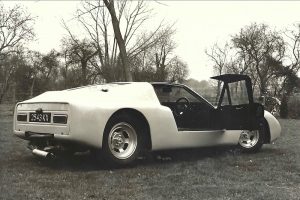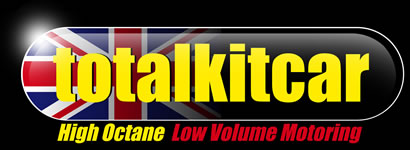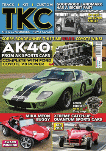A marvellous subject for Classic Kit Cars & Specials is GRAND PRIX METALCRAFT, which belongs right up with the very best specialist car and racing car metal bashers such as Williams & Pritchard, Wakefields, The Robert Peel Company, Maurice Gomm, Shapecraft and Arch Motor & Engineering.
Founded in 1968, by brothers Peter and Bob (b 1933) Hingerton with their friend Alf Goodenough (b 1934) in North London.
The three had met at aircraft manufacturer Handley Page in Cricklewood in the mid-fifties where they served a seven-year engineering apprenticeship in the company’s metal workshop. They then moved to Rolls-Royce subsidiary coachbuilders Mulliner Park Ward in Willesden before they joined Aston Martin in Newport Pagnell.
There then was a period spent apart, with Peter Hingerton joining racer and Hillman Imp expert, Roger Nathan Racing in Fortis Green where he was employed as a sheet metal worker. Meanwhile, his brother Bob and Alf Goodenough returned to Handley Page, by then in Radlett.
Given that pedigree, it’s hardly surprising that in 1968 they decided to set up Grand Prix Metalcraft (also known as GP Metalcraft) based on the same site as Nathan at Lynton Garage, part of the Thane Villa premises, off the Seven Sisters Road in Fortis Green. Also based in or around that building, up a nondescript puddle-laden, cobbled alleyway, was Paul Hawkins Racing and David Piper Racing.
While working for Roger Nathan, it dawned on Peter that there was a market for their skills within the motorsport world, so it was his idea for his brother and friend Alf to get the proverbial band back together. The Grand Prix Metalcraft name was a bit speculative as Hingerton felt that he would easily be able to get work from the Grand Prix fraternity. He certainly aimed high. However, he was proven right, very quickly.

Whereas some rival companies concentrated on one specific area of metalwork, Grand Prix Metalcraft’s strength was their versatility, as well as their craftsmanship, of course.
One of their first projects was Project 212 for Aston Martin followed by Syd Marler’s Ellova Clubman car, while their neighbours Nathan, Hawkins and Piper brought work to them too.
An early volume job came from an American customer for whom they fabricated chopper bike frames and ‘springer’ front fork setups. They had made over 2500 of the latter by the late seventies. They managed to produce a massive amount of work given their relatively small workshop – offices and admin were located upstairs – staffed by a team of twelve in addition to the directors.
Peter Hingerton was managing director although he split his time between office work and workshop time. He was an ace welder and he put together a lot of components and panels that had been produced in the morning, doing this work in the afternoon and often into the evening. Hingerton was renowned for the quality of his welding and ‘row of pennies’ welds.
They loved bespoke work and one-off jobs but didn’t waste time on time-consuming jobs like complete bodies for vintage cars although they always had a demand. They did offer a certain amount of off-the-shelf stock parts like dry sumps and tanks of various types. These were usually for various single-seaters like F2, F3, FF1600 and Formula Atlantic, although road and rally cars were also catered for.
Their biggest seller was their dry sump kits, while three sizes of tank were offered plus they also produced four- or six-gallon fuel tanks, too. These were usually fabricated in L59 alloy sheet. Another skilled employee was Clive Bracey who was responsible for hand producing the caps for their tanks.
Trade work included tanks and complete bodies for Brian Angliss of AC Autokraft for his range of Cobras, plus tanks for GT40 king John Etheridge’s cars, as well as monocoque repair work on the latter’s GT40 restorations.
Derek Bennett of Chevron was a customer and Grand Prix Metalcraft fabricated fuel collector tanks for his F2 cars, while Chris Lawrence had them produce header and heater tanks for his Monicas.
The company was also known for its range of rear wings for racing cars, particularly for Formula One teams, which were formed in aluminium or for non-F1 work in NS4 22-gauge alloy sheet.
If customers wanted their parts cadmium plated this was done in-house albeit in a separate building. They did produce full monocoques for F1 customers but shied away from that work otherwise, although there were exceptions like Brian Hampsheir’s Elden Race Cars, while they also fashioned aluminium side panels for the likes of Robin Herd’s March Engineering.
There was other stuff for Formula One clients other than monocoques and rear wings as they also fabricated nosecones, oil tanks and oil coolers. Hingerton was heavily involved in the development of Graham Hill’s Embassy-Hill F1 cars as well as Emerson and Wilson Fittipaldi’s Copersucars.
Grand Prix Metalcraft welcomed work from specialist car manufacturers and actively offered to produce aluminium bodies for prototypes (cars that the Hingertons had often also developed and built) from which the client could produce a set of GRP moulds for production. Peter Hingerton making the point that for often cash-strapped low-volume makers this was a far cheaper route than starting with a master buck in GRP.
The Chevron B19 Spider was produced in this way, as was the Silhouette GS70 kitcar as well as the American neo-classic Desande, to name but a few.
Among the varied work was Maserati 250F bodies for Cameron Millar and Innes Ireland, Jaguar D-type bodies, ERA-Delage panels and even Bentley Mk6 bodies although Peter tried to avoid doing them due to the time involved in making them.
In 1973, the oil crisis and three-day week made the Hingertons and Goodenough very nervous, so they decided to diversify into non-automotive work. For instance, they formed a new company called Proto Excel with their friend Chris Craft who designed beautiful – if expensive – aluminium furniture that Grand Prix Metalcraft’s staff produced. Craft had a retail outlet where they were displayed and sold.
They also produced the wonderful statues created by sculptor Andrew Mylius, which kept them busy.
By the early eighties, the company got into the world of modified cars working on stretched and wild-looking Mercedes-Benz S Class’ among others before getting into the world of six-wheeled Range Rovers often used by clients in the Middle East for falconry purposes.
This was a sector occupied by several companies particularly Glenfrome, but Grand Prix Metalcraft were regarded as among the wildest.
In 1994 the company went into receivership. A sad end of a legendary company. I’ve heard some great stories about the Hingertons and Alf Goodenough, while their work is regarded incredibly highly and they were firmly seated at the top table of companies involved in sixties motorsport.









